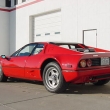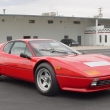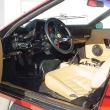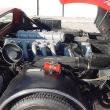1984 Ferrari 512 BBi
Designed by Pininfarina and built by Scaglietti, the mid-engined Boxer was the successor to the front engined V12 Daytona. The original Boxer, known as the 365 GT4 BB was first shown at the Turin Motor Show in 1971 but did not go on sale until 1974. Introduced at the Paris Salon in 1976, the 512 BB superseded the 365 GT4 BB; its engine was enlarged from 4390 cc to 4942 cc, although the horse power dropped from 380 bhp at 7000 rpm in the 365 GT4 BB to 630 bhp at 6200 rpm to meet noise and emission regulations, particularly in the USA. The 512 BB body varied little from its predecessor, although the rear-end was widened to accommodate new wider tires and two sets of rear lights which replaced the previous six. The six exhaust pipes were replaced by two double exhausts and a new spoiler was added at the front under the grille. The new engine and tires made the 512 BB a much more driveable car. In 1981 the 512 BB was replaced by the fuel injected, but otherwise almost identical 512 BBi. This model proved to be the most popular and 1007 were built until production ended in 1984.
The 512 BB designation can be broken down; the 5 indicates the displacement, although it is actually just under at 4942 cc, the 12 represents the number of cylinders that are capable of producing 360 bhp. The first B is for Berlinetta, which is essentially a closed coupe, the second B stands for Boxer.
The name ‘Boxer’ comes from the engine which is vertically opposed, meaning the cylinders are arranged in a flat configuration and opposed to each other by 180 degrees. This was the first time Ferrari had used a Boxer engine in a road going car and the Flat 12 made it possible to mount the engine above the transmission, which allowed the space to create a better driving position. The Boxer engine was extremely powerful giving a top speed of 188 mph, 0-60 in 5.5 seconds and 0-100 in just 13.2 seconds. The positioning of the engine also added to handling the centralized weight allowing for faster cornering.
The car is built around a tubular steel frame which holds the engine, transmission, steering and suspension components. The cabin is made of steel, the lower body panels are formed from fiberglass and the nose and tail are clothed in alloy clamshells. The panels joints are all obvious, with no attempt made to hide them. The wishbone suspension is surrounded with twin coil springs at the rear and the steering is rack and pinion. All of the details add to the pure race driving experience.
When designing the Boxer, Pininfarina did away with years of Ferrari design culminated in the Daytona and created a true racing car for the road. The Daytona looked back, the Boxer forward to a new era of mid-engined supercars. The Boxer was low slung and racy and was in direct competition with the mid-engined Lamborghini Miura. Ferrari had their racing heritage, experience and dominance with the 312PB to draw from and this gave the Boxer its competitive edge. The racing influence is carried into the spartan interior. The car is designed and built around the driver and heightening their experience leaves little storage space.
The 512 BBi in the Mathews Collection was one of the last of this model to be built and Harry often uses it for his personal transport. The air conditioning, power windows and central locking doors which all come as standard help make this an easy car for everyday use. The 512 BBi is fine for normal speeds, but doesn’t really come alive until it reaches velocity. The acceleration is incredibly quick and with the engine just behind the driver’s head, motoring becomes a multi-sensational experience.



